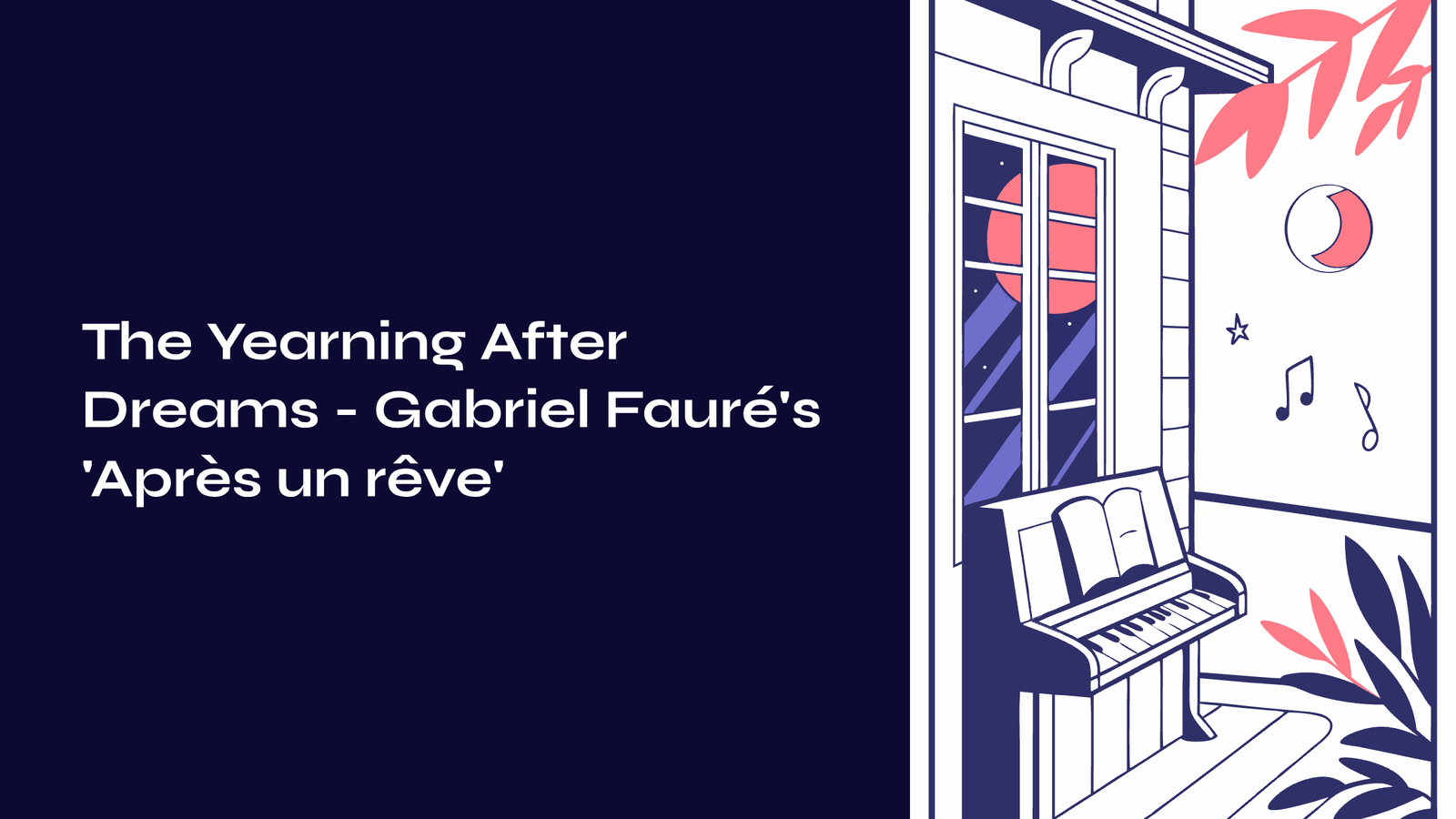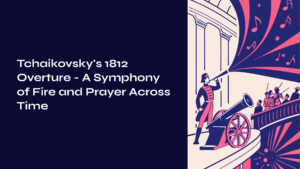Table of Contents
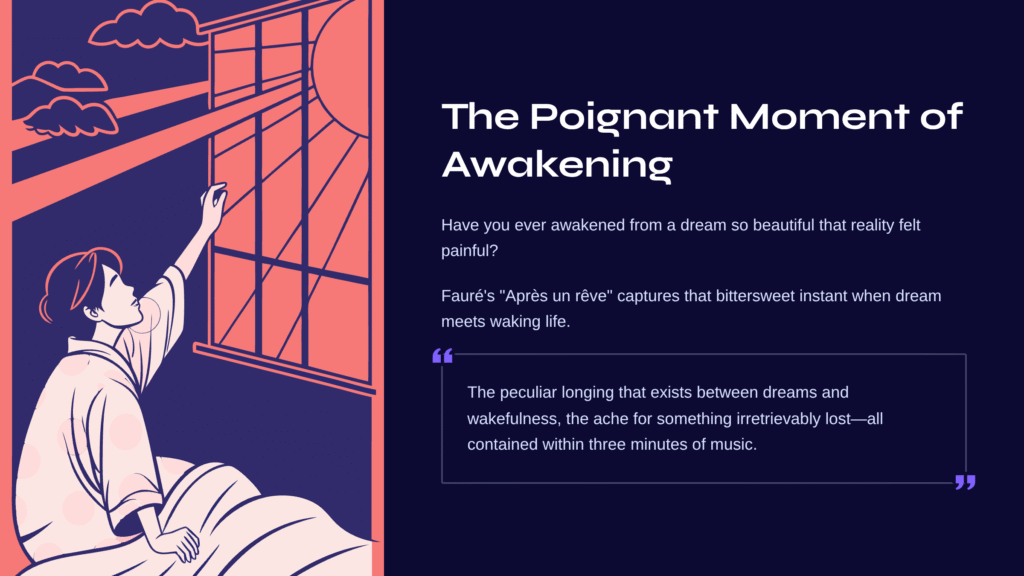
The Poignant Moment of Awakening
Have you ever awakened from a dream so beautiful that returning to reality felt almost painful? That moment when the echoes of a perfect dream still linger in your consciousness, making the waking world seem pale by comparison. Gabriel Fauré’s “Après un rêve” (After a Dream) captures precisely that bittersweet instant when we must leave behind the sanctuary of dreams.
When I first encountered this piece, it felt as though someone had peered into the most intimate corners of my soul and translated those unspoken feelings into melody. The peculiar longing that exists in the liminal space between dreams and wakefulness, the ache for something irretrievably lost—all of this was contained within a mere three minutes of music, yet with such completeness that it took my breath away.
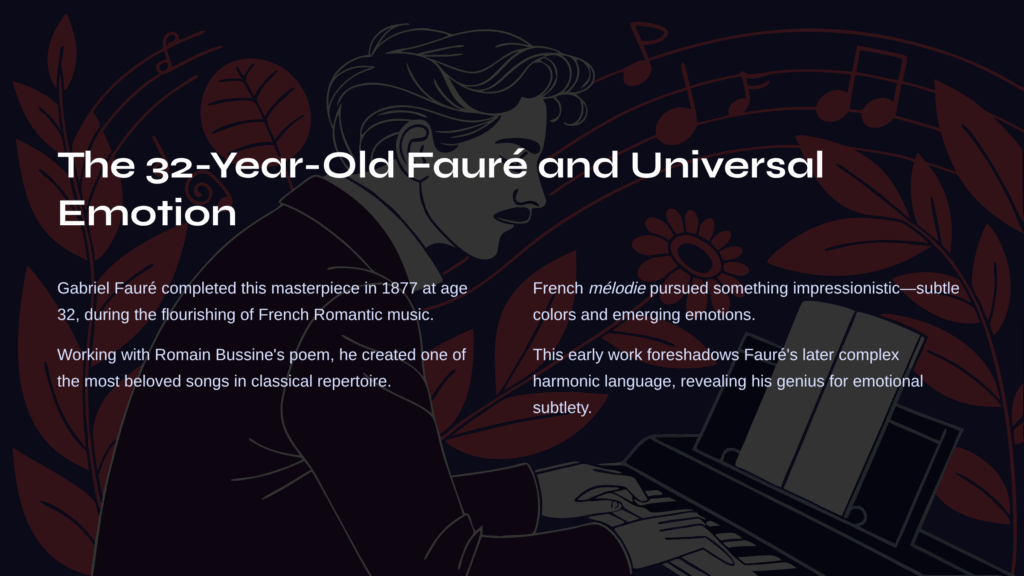
The 32-Year-Old Fauré and Universal Emotion
Gabriel Fauré completed this masterpiece in 1877 when he was 32 years old, during the flourishing of French Romantic music. Working with a poem by Romain Bussine (adapted from an anonymous Italian original), Fauré created what would become one of the most beloved songs in the classical repertoire.
French mélodie of this period possessed a distinct character that set it apart from German Lieder. Where German art songs often embraced philosophical depth and dramatic narratives, French songs pursued something more impressionistic—a subtle play of colors and emotions that seemed to capture feelings as they emerged, before they could be fully articulated. Fauré’s “Après un rêve” embodies the very essence of this French sensibility.
What makes this work particularly fascinating is how it foreshadows the complex harmonic language of Fauré’s later compositions, despite being from his relatively early period. Beneath what appears to be a simple, flowing melody lies a sophisticated network of harmonic relationships that reveal the composer’s genius for emotional subtlety.
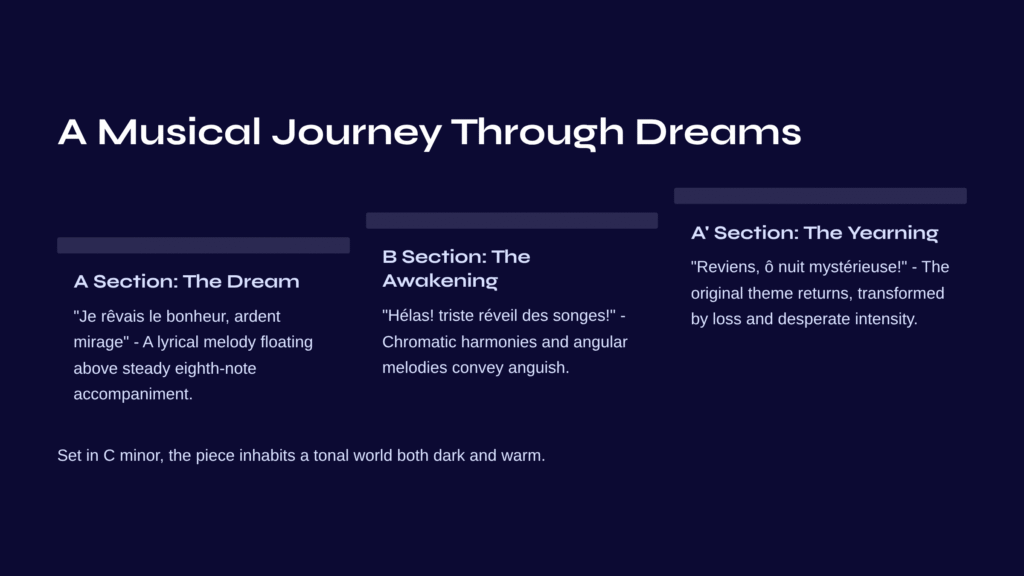
A Musical Journey Through the Landscape of Dreams
The song’s structure follows an A-B-A’ form that mirrors the emotional arc of dreaming, awakening, and remembering. Set in C minor, the piece inhabits a tonal world that is simultaneously dark and warm, perfectly suited to express both the sweetness of the dream and the melancholy of its loss.
The opening A section unfolds with the words “Je rêvais le bonheur, ardent mirage” (I dreamed of happiness, fervent mirage). Here, Fauré’s right hand spins out a lyrical melody that seems to float above the steady eighth-note accompaniment in the left hand. This accompaniment pattern, seemingly simple, actually contains subtle harmonic shifts that suggest the unstable, ever-changing nature of dreams themselves.
The central B section brings us to the heart of the song’s emotional crisis: “Hélas! Hélas, triste réveil des songes!” (Alas! Alas, sad awakening from dreams!). Here, Fauré employs more chromatic harmonies and angular melodic lines to convey the speaker’s anguish. The music itself seems to stumble and falter, as if the very act of awakening is a kind of musical rupture.
The return of the A section (A’) brings back the original theme, but now it’s colored by what we’ve experienced in the middle section. The plea “Reviens, reviens radieuse, Reviens, ô nuit mystérieuse!” (Return, return radiant one, Return, O mysterious night!) carries a desperate intensity that wasn’t present in the opening. It’s the same melody, but transformed by loss.
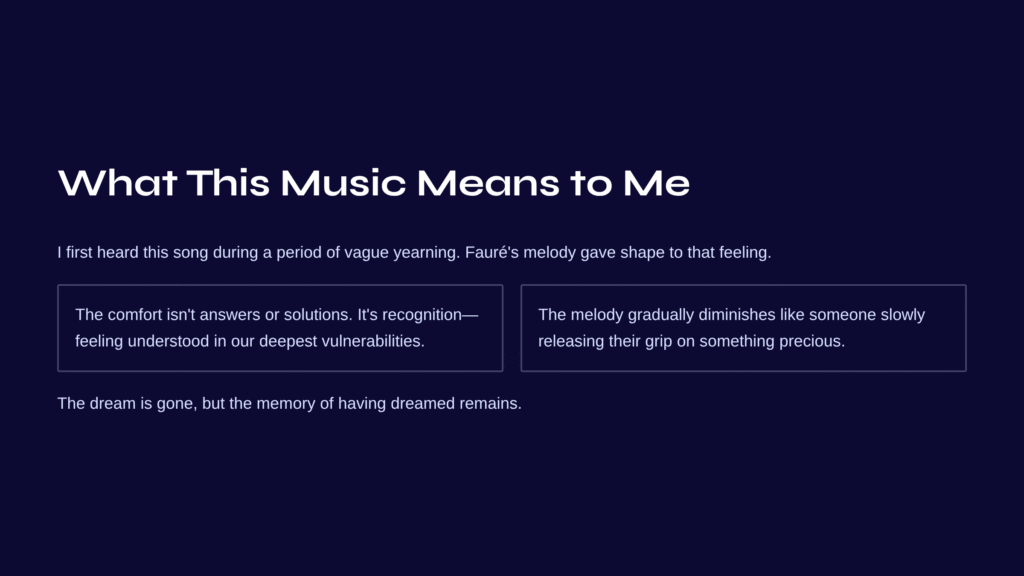
What This Music Means to Me
I first heard this song during a period when I was grappling with my own sense of loss—not of anything specific, but rather that vague yearning that sometimes settles over us without clear cause. Fauré’s melody gave name and shape to that feeling, making it somehow more bearable by making it beautiful.
The comfort this piece offers isn’t the comfort of answers or solutions. Instead, it’s the comfort of recognition—of feeling understood in our deepest vulnerabilities. There’s something profoundly validating about hearing your own emotional experience reflected so perfectly in music composed over a century ago. It reminds us that these feelings of longing, of beautiful loss, are part of the human condition itself.
What moves me most about the song’s ending is how the melody gradually diminishes and fades away. It’s not dramatic or tragic—it’s gentle, like someone slowly releasing their grip on something precious. There’s acceptance there, even peace. The dream is gone, but the memory of having dreamed remains, and perhaps that’s enough.
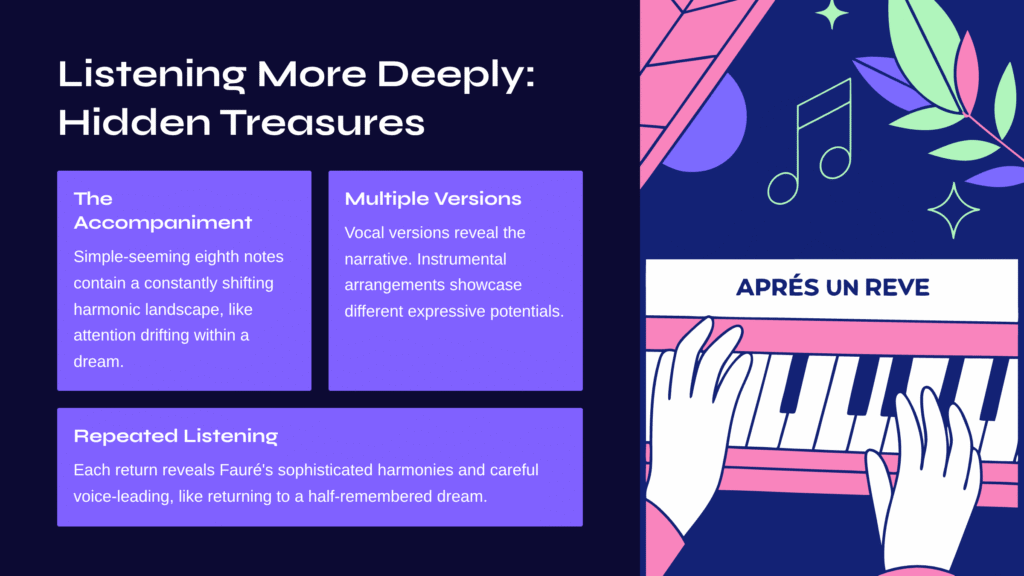
Listening More Deeply: Hidden Treasures
If you want to truly appreciate the subtleties of this piece, there are several elements worth your attention.
First, listen carefully to the left-hand accompaniment. What might sound like simple, repetitive eighth notes actually contains a constantly shifting harmonic landscape. Fauré uses these subtle changes to keep the music flowing and evolving, much like the way our attention drifts and focuses within a dream.
Second, if possible, listen to both vocal and instrumental versions. The original song with voice allows you to follow the narrative arc of the poem, while arrangements for cello, violin, or other instruments reveal different aspects of the melody’s expressive potential. Each instrument brings its own color to Fauré’s musical canvas.
Finally, this is music that rewards repeated listening. On first hearing, you might be swept away by the surface beauty of the melody. But return to it again and again, and you’ll begin to notice Fauré’s sophisticated harmonic progressions, his careful voice-leading, and the way he uses small musical gestures to create large emotional effects. Like returning to a half-remembered dream, each listening reveals new details and deeper layers of meaning.
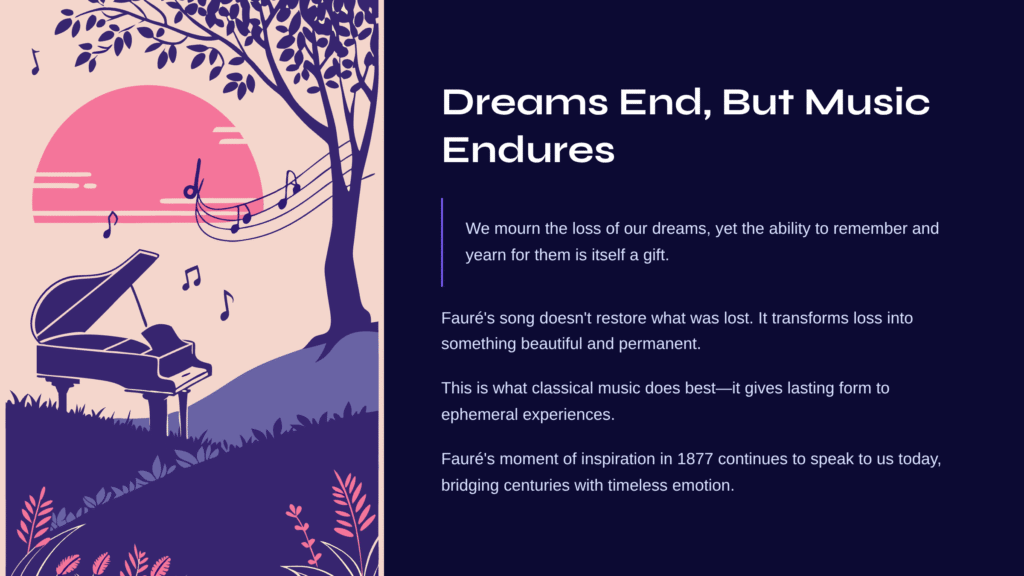
Dreams End, But Music Endures
Every time I listen to “Après un rêve,” I’m struck by a paradox: we mourn the loss of our dreams, yet the very ability to remember and yearn for them is itself a kind of gift. Fauré’s song doesn’t offer to restore what was lost; instead, it transforms that loss into something beautiful and permanent.
This is perhaps what classical music does best—it takes our most ephemeral experiences and gives them lasting form. The 32-year-old Fauré’s moment of inspiration in 1877 continues to speak to listeners today, bridging the centuries with its expression of timeless human emotion. In a world where so much changes and passes away, music remains as a constant reminder that beauty, once created, never truly dies.
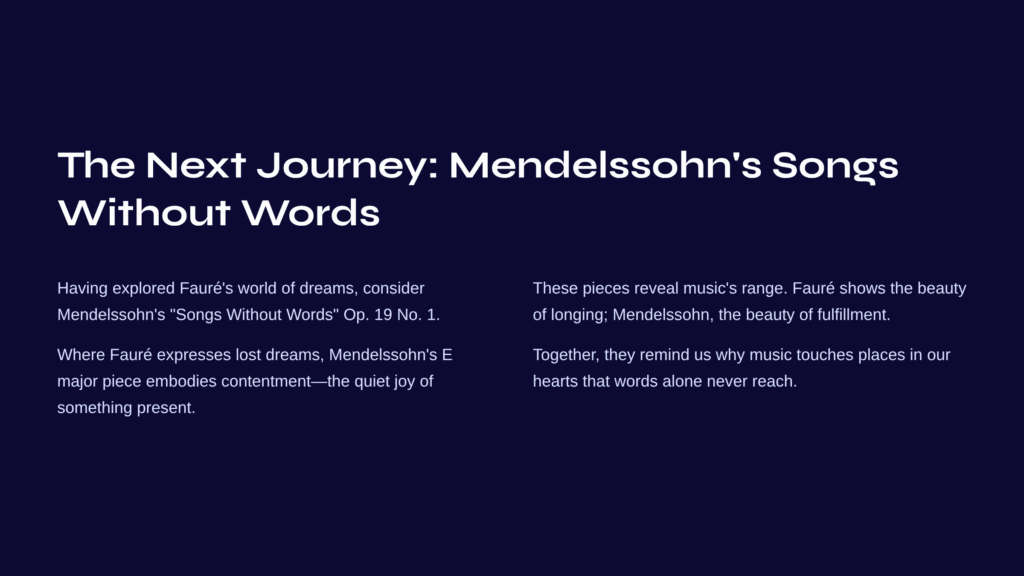
The Next Journey: Mendelssohn’s Songs Without Words
Having explored Fauré’s world of dreams and awakening, perhaps it’s time to experience a different kind of musical poetry. Felix Mendelssohn’s “Songs Without Words” Op. 19 No. 1 demonstrates how profound emotion can be conveyed through pure instrumental melody, without the aid of text.
Where Fauré’s song uses the marriage of poetry and music to express the pain of lost dreams, Mendelssohn’s “song without words” shows us how melody alone can speak directly to the heart. The piece, in E major, offers a gentle, flowing character that feels like a musical embodiment of contentment—not the yearning after something lost, but the quiet joy of something present and perfect.
Listening to these two pieces in succession reveals the remarkable range of human emotion that music can express. Fauré shows us the beauty of longing; Mendelssohn, the beauty of fulfillment. Together, they remind us why music remains one of humanity’s most essential forms of expression, capable of touching places in our hearts that words alone can never reach.
